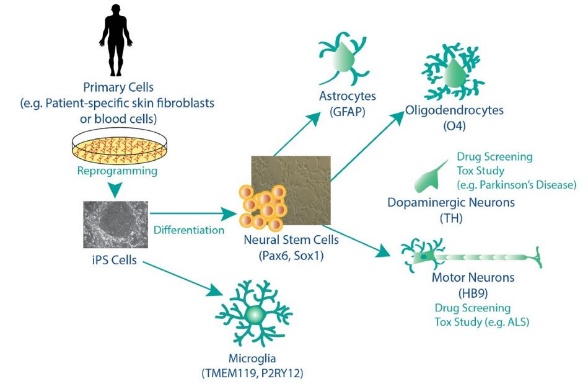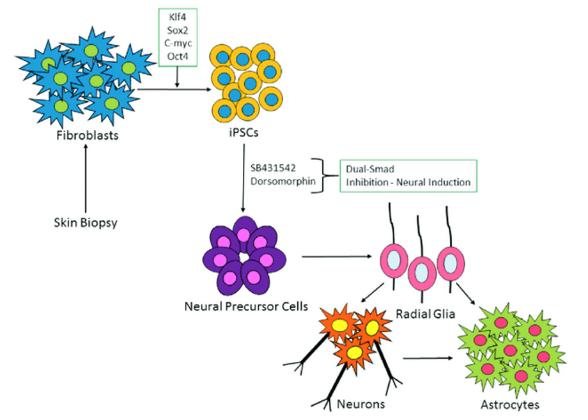- You are here: Home
- Resources
- Explore & Learn
- Cell Biology
- Neural Differentiation from Induced Pluripotent Stem Cells
Support
-
Cell Services
- Cell Line Authentication
- Cell Surface Marker Validation Service
-
Cell Line Testing and Assays
- Toxicology Assay
- Drug-Resistant Cell Models
- Cell Viability Assays
- Cell Proliferation Assays
- Cell Migration Assays
- Soft Agar Colony Formation Assay Service
- SRB Assay
- Cell Apoptosis Assays
- Cell Cycle Assays
- Cell Angiogenesis Assays
- DNA/RNA Extraction
- Custom Cell & Tissue Lysate Service
- Cellular Phosphorylation Assays
- Stability Testing
- Sterility Testing
- Endotoxin Detection and Removal
- Phagocytosis Assays
- Cell-Based Screening and Profiling Services
- 3D-Based Services
- Custom Cell Services
- Cell-based LNP Evaluation
-
Stem Cell Research
- iPSC Generation
- iPSC Characterization
-
iPSC Differentiation
- Neural Stem Cells Differentiation Service from iPSC
- Astrocyte Differentiation Service from iPSC
- Retinal Pigment Epithelium (RPE) Differentiation Service from iPSC
- Cardiomyocyte Differentiation Service from iPSC
- T Cell, NK Cell Differentiation Service from iPSC
- Hepatocyte Differentiation Service from iPSC
- Beta Cell Differentiation Service from iPSC
- Brain Organoid Differentiation Service from iPSC
- Cardiac Organoid Differentiation Service from iPSC
- Kidney Organoid Differentiation Service from iPSC
- GABAnergic Neuron Differentiation Service from iPSC
- Undifferentiated iPSC Detection
- iPSC Gene Editing
- iPSC Expanding Service
- MSC Services
- Stem Cell Assay Development and Screening
- Cell Immortalization
-
ISH/FISH Services
- In Situ Hybridization (ISH) & RNAscope Service
- Fluorescent In Situ Hybridization
- FISH Probe Design, Synthesis and Testing Service
-
FISH Applications
- Multicolor FISH (M-FISH) Analysis
- Chromosome Analysis of ES and iPS Cells
- RNA FISH in Plant Service
- Mouse Model and PDX Analysis (FISH)
- Cell Transplantation Analysis (FISH)
- In Situ Detection of CAR-T Cells & Oncolytic Viruses
- CAR-T/CAR-NK Target Assessment Service (ISH)
- ImmunoFISH Analysis (FISH+IHC)
- Splice Variant Analysis (FISH)
- Telomere Length Analysis (Q-FISH)
- Telomere Length Analysis (qPCR assay)
- FISH Analysis of Microorganisms
- Neoplasms FISH Analysis
- CARD-FISH for Environmental Microorganisms (FISH)
- FISH Quality Control Services
- QuantiGene Plex Assay
- Circulating Tumor Cell (CTC) FISH
- mtRNA Analysis (FISH)
- In Situ Detection of Chemokines/Cytokines
- In Situ Detection of Virus
- Transgene Mapping (FISH)
- Transgene Mapping (Locus Amplification & Sequencing)
- Stable Cell Line Genetic Stability Testing
- Genetic Stability Testing (Locus Amplification & Sequencing + ddPCR)
- Clonality Analysis Service (FISH)
- Karyotyping (G-banded) Service
- Animal Chromosome Analysis (G-banded) Service
- I-FISH Service
- AAV Biodistribution Analysis (RNA ISH)
- Molecular Karyotyping (aCGH)
- Droplet Digital PCR (ddPCR) Service
- Digital ISH Image Quantification and Statistical Analysis
- SCE (Sister Chromatid Exchange) Analysis
- Biosample Services
- Histology Services
- Exosome Research Services
- In Vitro DMPK Services
-
In Vivo DMPK Services
- Pharmacokinetic and Toxicokinetic
- PK/PD Biomarker Analysis
- Bioavailability and Bioequivalence
- Bioanalytical Package
- Metabolite Profiling and Identification
- In Vivo Toxicity Study
- Mass Balance, Excretion and Expired Air Collection
- Administration Routes and Biofluid Sampling
- Quantitative Tissue Distribution
- Target Tissue Exposure
- In Vivo Blood-Brain-Barrier Assay
- Drug Toxicity Services
Neural Differentiation from Induced Pluripotent Stem Cells
Effective and efficient generation of human neural stem cells and subsequently functional neural populations from pluripotent stem cells has facilitated advancements in the study of human development and disease modeling. Almost all types of neural cells, including but not limited to neural stem cells, neurons, astrocytes, oligodendrocytes, and microglia, can be derived from induced pluripotent stem cells (iPSCs) following developmental principles.
Neural Stem Cells

- Neural stem cells (NSCs) provide a life-long resource of neurons and glial cells in the brain and serve as the root for adult neurogenesis to develop, repair, and modulate nervous system functions. Using iPSC-derived NSCs, a wide range of neurological diseases have been studied, including monogenic and complex neural disorders.
- Through a carefully controlled series of signaling pathways and growth factors, iPSCs are guided toward a neuroectodermal fate. This commitment marks the beginning of neural differentiation, where the cells adopt NSC characteristics. These NSCs express characteristic markers, including N-Cadherin, SOX2, and NESTIN.
Neurons
- Neurons are the fundamental functional units of the nervous system, responsible for transmitting electrical signals and enabling communication between different regions of the brain. The specific types of neurons developed from iPSCs have been applied to neurological disease modeling and disease phenotype characterization.
- By modulating the expression of specific transcription factors and growth factors, iPSC-derived NSCs can be directed toward the neuronal lineage. For example, by controlling the activation of the Wnt signaling pathway and adding neurotrophic factors such as brain-derived neurotrophic factor (BDNF) and nerve growth factor (NGF), neurons with different phenotypes can be successfully generated.
Astrocytes

- With the growing knowledge of astrocyte biology, its role in neurological diseases is now increasingly appreciated. Similar to neurons, astrocytes are patterned by morphogen gradients along the rostro-dorsal axis and dorsal-ventral axis and exhibit heterogeneity in terms of subtypes and regionalities.
- However, the protocols of astrocyte differentiation from iPSCs remain limited. It is reported that using different combinations of RA, FGF8, and SHH to pattern astrocytes at the neural epithelial stage can generate spinal cord astrocytes in a shorter time.
Oligodendrocytes
Oligodendrocyte differentiation from iPSCs initially followed methods of ESC differentiation, including sequential induction of neural epithelial cells by RA and FGF, ventralization using SHH, and administration of PDGF to improve OPC expansion.
Microglia
In recent years, the derivation of microglia from iPSCs has become the focus of great interest. Some reports developed microglia-like cells from both human iPSCs and ESCs by inducing myeloid progenitors from EBs, mimicking yolk sac structures. These microglia-like cells express microglia-specific transcriptional factor PU.1 and surface markers IBA1, CD45 and CD11B.
Creative Bioarray Relevant Recommendations
The ability to differentiate iPSCs into specific neural cell types, such as NSCs, neurons, astrocytes, oligodendrocytes, and microglia, has opened up new avenues in neuroscience research and regenerative medicine. Creative Bioarray is an experienced and outstanding provider of neural and astrocyte differentiation services and differentiation kits.
| Services and Product Types | Description |
| Neural Stem Cells Differentiation | The process of iPSC differentiation to neurons and neuronal cells is of special importance for neurobiology and related disorders, considering the dearth of clinically relevant in vitro models available for research. |
| Astrocyte Differentiation | The generation of astrocytes derived from pluripotent stem cells opens up a new area for studying neurologic diseases in vitro, these models could be exploited to identify and validate potential drugs by detecting adverse effects in the early stages of drug development. |
| iPSC Differentiation Kits | We offer a wide range of products to support IPS Cell differentiation. These differentiated cells provide a highly desirable in vitro high-content toxicity and drug screening platform. |
For research use only. Not for any other purpose.

